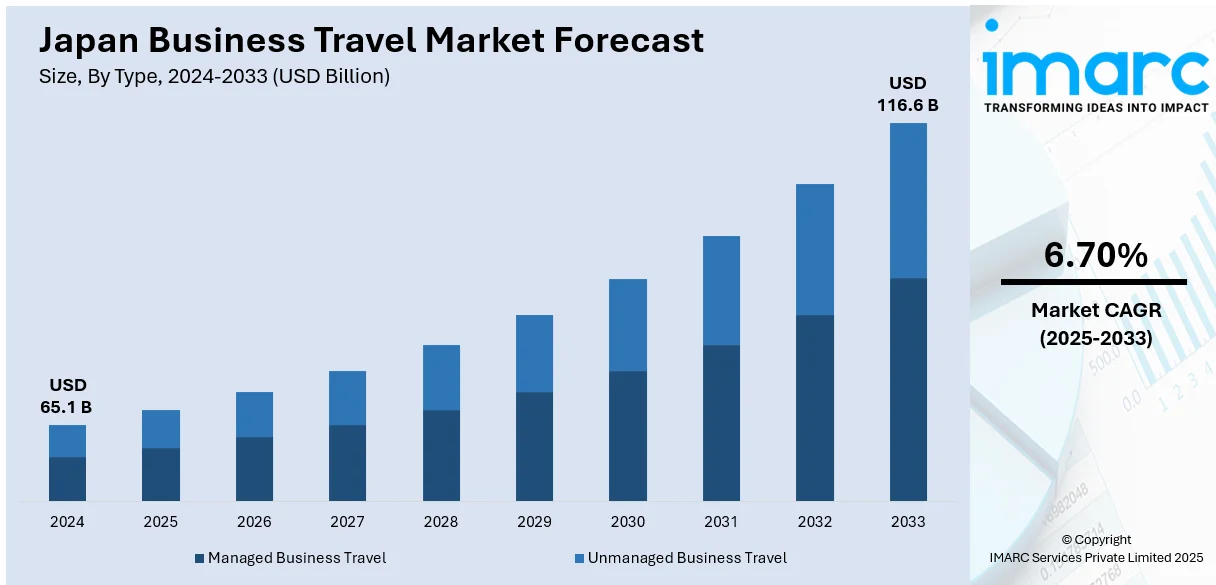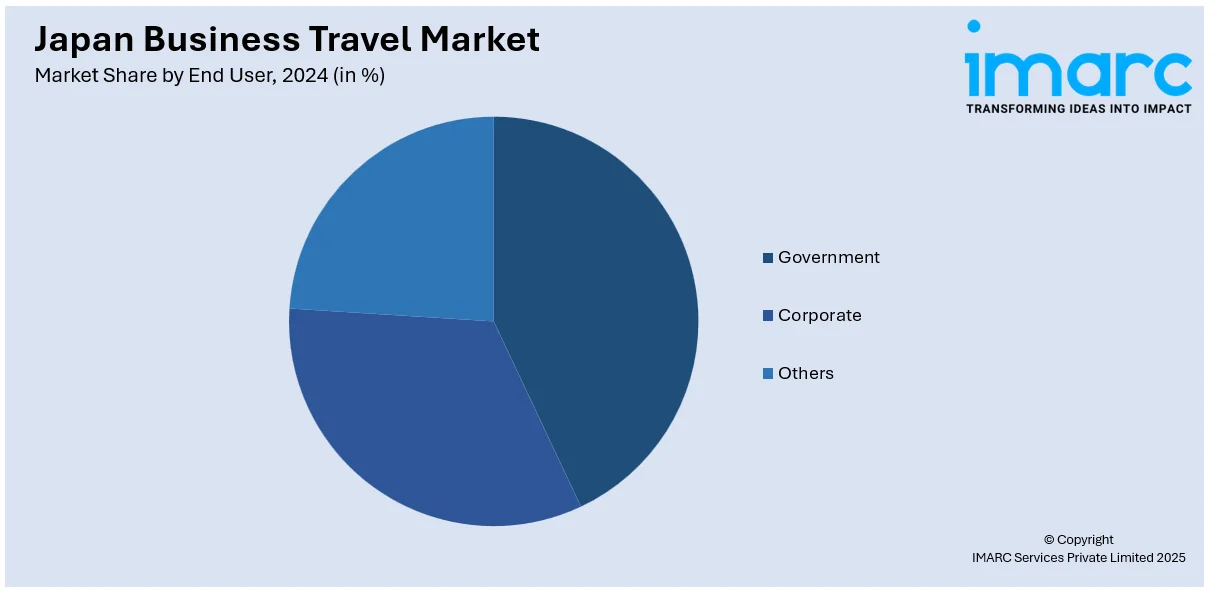
Japan Business Travel Market Size, Share, Trends and Forecast by Type, Purpose Type, Expenditure, Age Group, Service Type, Travel Type, End User, and Region, 2025-2033
Japan Business Travel Market Overview:
The Japan business travel market size reached USD 65.1 Billion in 2024. Looking forward, IMARC Group expects the market to reach USD 116.6 Billion by 2033, exhibiting a growth rate (CAGR) of 6.70% during 2025-2033. Rising regional trade, expansion of multinational operations, growth in meetings and conferences, digital transformation of travel services, government support for tourism infrastructure, and increasing demand for client-facing engagements, particularly across finance, manufacturing, and technology sectors, are some of the factors propelling the growth of the market.
|
Report Attribute
|
Key Statistics
|
|---|---|
|
Base Year
|
2024
|
|
Forecast Years
|
2025-2033
|
|
Historical Years
|
2019-2024
|
| Market Size in 2024 | USD 65.1 Billion |
| Market Forecast in 2033 | USD 116.6 Billion |
| Market Growth Rate 2025-2033 | 6.70% |
Japan Business Travel Market Trends:
Rising Global Momentum in Corporate Mobility
Business-related travel is experiencing a steady revival as international operations, client engagements, and inter-regional coordination continue to expand. Growing demand for face-to-face meetings, regional conferences, and corporate events is contributing to increased travel activity. For Japan, a country deeply integrated with global supply chains and multilateral trade partnerships, this shift is reflected in higher inbound and outbound corporate travel movement. Companies are resuming in-person negotiations, site visits, and collaboration sessions, viewing physical presence as key to building trust and maintaining business continuity. Improvements in airline connectivity, travel infrastructure, and digital booking systems further support this uptick. At the same time, flexible travel policies and expanded loyalty programs are enhancing mobility across business tiers, from executive leadership to field-level staff. The shift underscores a broader return to direct interaction, where strategic coordination, investment exploration, and market expansion activities are increasingly conducted in person, reinforcing Japan’s role as a hub for high-value corporate engagement. For example, the global business travel market size reached USD 1.1 Trillion in 2024. Looking forward, IMARC Group expects the market to reach USD 2.0 Trillion by 2033, exhibiting a growth rate (CAGR) of 6.3% during 2025-2033.

Digitalization of Corporate Travel Services
Business travel in Japan is seeing increased integration of digital platforms designed to streamline planning, booking, and expense management. New solutions are being introduced to support enterprise clients with customizable tools that improve efficiency and control over travel logistics. Regional partnerships are playing a key role in adapting these systems to local needs, ensuring compliance and service personalization. As Japanese companies continue to expand operations across Asia-Pacific, the demand for agile, tech-enabled travel support is growing. Local collaborations are helping bridge cultural and operational expectations while elevating the standard of business travel experiences. These developments reflect a broader shift toward automation, transparency, and centralized management in business mobility, especially for companies seeking to optimize budgets and ensure seamless regional coordination. For instance, in October 2024, Trip.Biz introduced its 'Product Matrix' during the 'Trip.Biz Transform 2024' conference in Singapore. The platform aims to enhance corporate travel management across Asia-Pacific. Tokyo Masters, Trip.Biz’s local partner in Japan, joined the event, signaling efforts to expand digital travel solutions tailored for Japanese business travelers.
Japan Business Travel Market Segmentation:
IMARC Group provides an analysis of the key trends in each segment of the market, along with forecasts at the region/country level for 2025-2033. Our report has categorized the market based on type, purpose type, expenditure, age group, service type, travel type, and end user.
Type Insights:
- Managed Business Travel
- Unmanaged Business Travel
The report has provided a detailed breakup and analysis of the market based on the type. This includes managed business travel and unmanaged business travel.
Purpose Type Insights:
- Marketing
- Internal Meetings
- Trade Shows
- Product Launch
- Others
A detailed breakup and analysis of the market based on the purpose type have also been provided in the report. This includes marketing, internal meetings, trade shows, product launch, and others.
Expenditure Insights:
- Travel Fare
- Lodging
- Dining
- Others
A detailed breakup and analysis of the market based on the expenditure have also been provided in the report. This includes travel fare, lodging, dining, and others.
Age Group Insights:
- Travelers Below 40 Years
- Travelers Above 40 Years
A detailed breakup and analysis of the market based on the age group have also been provided in the report. This includes travelers below 40 years and travelers above 40 years.
Service Type Insights:
- Transportation
- Food and Lodging
- Recreational Activities
- Others
A detailed breakup and analysis of the market based on the service type have also been provided in the report. This includes transportation, food and lodging, recreational activities, and others.
Travel Type Insights:
- Group Travel
- Solo Travel
A detailed breakup and analysis of the market based on the travel type have also been provided in the report. This includes group travel and solo travel.
End User Insights:

- Government
- Corporate
- Others
A detailed breakup and analysis of the market based on the end user have also been provided in the report. This includes government, corporate, and others.
Regional Insights:
- Kanto Region
- Kansai/Kinki Region
- Central/Chubu Region
- Kyushu-Okinawa Region
- Tohoku Region
- Chugoku Region
- Hokkaido Region
- Shikoku Region
The report has also provided a comprehensive analysis of all the major regional markets, which include Kanto region, Kansai/Kinki region, Central/Chubu region, Kyushu-Okinawa region, Tohoku region, Chugoku region, Hokkaido region, and Shikoku region.
Competitive Landscape:
The market research report has also provided a comprehensive analysis of the competitive landscape. Competitive analysis such as market structure, key player positioning, top winning strategies, competitive dashboard, and company evaluation quadrant has been covered in the report. Also, detailed profiles of all major companies have been provided.
Japan Business Travel Market News:
- In March 2025, the UK and Japan launched a new economic partnership to strengthen trade and investment across sectors, including technology, finance, and clean energy. The agreement supports increased cross-border business activity, which is expected to drive corporate travel between the two nations. This collaboration reflects both governments' commitment to fostering international business engagement and growth.
Japan Business Travel Market Report Coverage:
| Report Features | Details |
|---|---|
| Base Year of the Analysis | 2024 |
| Historical Period | 2019-2024 |
| Forecast Period | 2025-2033 |
| Units | Billion USD |
| Scope of the Report |
Exploration of Historical Trends and Market Outlook, Industry Catalysts and Challenges, Segment-Wise Historical and Future Market Assessment:
|
| Types Covered | Managed Business Travel, Unmanaged Business Travel |
| Purpose Types Covered | Marketing, Internal Meetings, Trade Shows, Product Launch, Others |
| Expenditures Covered | Travel Fare, Lodging, Dining, Others |
| Age Groups Covered | Travelers Below 40 Years, Travelers Above 40 Years |
| Service Types Covered | Transportation, Food and Lodging, Recreational Activities, Others |
| Travel Types Covered | Group Travel, Solo Travel |
| End Users Covered | Government, Corporate, Others |
| Regions Covered | Kanto Region, Kansai/Kinki Region, Central/Chubu Region, Kyushu-Okinawa Region, Tohoku Region, Chugoku Region, Hokkaido Region, Shikoku Region |
| Customization Scope | 10% Free Customization |
| Post-Sale Analyst Support | 10-12 Weeks |
| Delivery Format | PDF and Excel through Email (We can also provide the editable version of the report in PPT/Word format on special request) |
Key Questions Answered in This Report:
- How has the Japan business travel market performed so far and how will it perform in the coming years?
- What is the breakup of the Japan business travel market on the basis of type?
- What is the breakup of the Japan business travel market on the basis of purpose type?
- What is the breakup of the Japan business travel market on the basis of expenditure?
- What is the breakup of the Japan business travel market on the basis of age group?
- What is the breakup of the Japan business travel market on the basis of service type?
- What is the breakup of the Japan business travel market on the basis of travel type?
- What is the breakup of the Japan business travel market on the basis of end user?
- What is the breakup of the Japan business travel market on the basis of region?
- What are the various stages in the value chain of the Japan business travel market?
- What are the key driving factors and challenges in the Japan business travel?
- What is the structure of the Japan business travel market and who are the key players?
- What is the degree of competition in the Japan business travel market?
Key Benefits for Stakeholders:
- IMARC’s industry report offers a comprehensive quantitative analysis of various market segments, historical and current market trends, market forecasts, and dynamics of the Japan business travel market from 2019-2033.
- The research report provides the latest information on the market drivers, challenges, and opportunities in the Japan business travel market.
- Porter's five forces analysis assist stakeholders in assessing the impact of new entrants, competitive rivalry, supplier power, buyer power, and the threat of substitution. It helps stakeholders to analyze the level of competition within the Japan business travel industry and its attractiveness.
- Competitive landscape allows stakeholders to understand their competitive environment and provides an insight into the current positions of key players in the market.
Need more help?
- Speak to our experienced analysts for insights on the current market scenarios.
- Include additional segments and countries to customize the report as per your requirement.
- Gain an unparalleled competitive advantage in your domain by understanding how to utilize the report and positively impacting your operations and revenue.
- For further assistance, please connect with our analysts.
 Request Customization
Request Customization
 Speak to an Analyst
Speak to an Analyst
 Request Brochure
Request Brochure
 Inquire Before Buying
Inquire Before Buying




.webp)




.webp)












